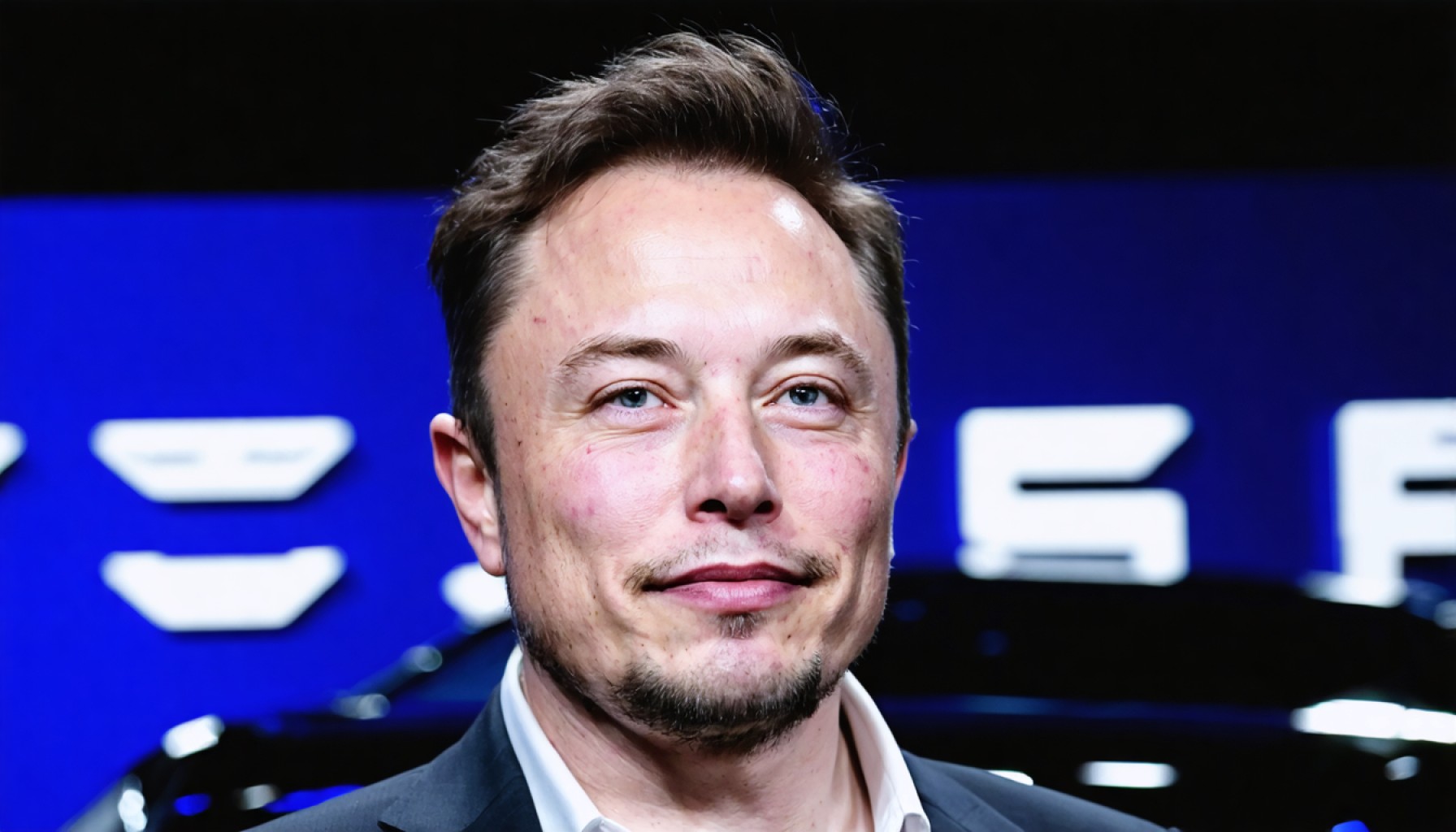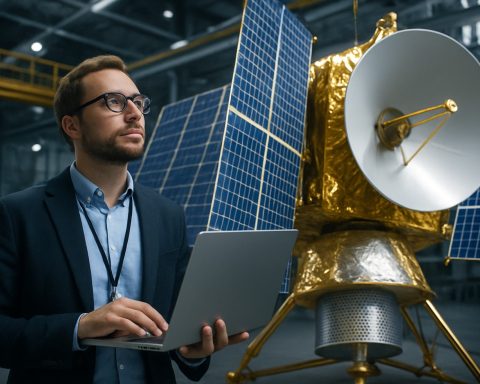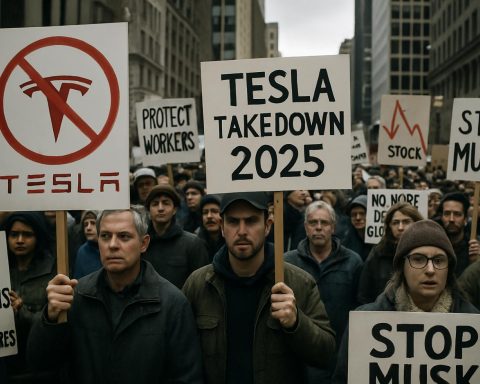- Tesla faces a complex crisis with a 71% drop in quarterly profits, driven by geopolitical tensions and CEO Elon Musk’s political dealings.
- Musk plans to shift focus back to Tesla, moving away from controversies and his involvement with the Department of Government Efficiency (DOGE).
- His political alignment with former President Donald Trump has impacted Tesla’s reputation and public perception.
- Trade policies, including a 25% tariff on imported vehicles, have disrupted the competitive landscape, affecting Tesla’s performance despite its domestic supply chain.
- Musk seeks to restore public trust and reaffirm Tesla’s commitment to clean energy amidst protests and showroom vandalism.
- By refocusing on innovation and assembly lines, Tesla aims to overcome market challenges and enhance its prospects for a sustainable future.
The whisper of electric engines on the road has long promised a transformative journey into the future. Yet, Tesla, a beacon of innovation in the automotive industry, has recently found itself at a precarious crossroad. A whirlwind of geopolitical tensions, market dynamics, and CEO Elon Musk’s own political entanglements have conspired to dim the luster of the company’s iconic brand.
Amid a dramatic 71% plunge in quarterly profits, the world watched as the tech maverick, Elon Musk, vowed to adjust his compass, steering away from his controversial engagement with the Department of Government Efficiency (DOGE) to renew his focus on Tesla. His dual commitments, stretching across bold technological realms, have sparked both awe and concern in equal measure. These commitments became even more burdensome as Tesla’s fortunes faltered in an economic climate rife with uncertainty.
The narrative began to unravel when Musk’s alignment with former President Donald Trump became more pronounced. This association, coupled with Musk’s role at DOGE, attracted public ire and painted an unintended target on Tesla’s reputation. The tech titan’s political overture seemed to clash with the clean energy ethos that initially captured the public’s imagination.
Complicating matters, President Trump’s aggressive trade policies, particularly a 25% tariff on imported passenger vehicles, have been instrumental in reshaping the competitive landscape. While Tesla prides itself on a largely domestic supply chain, these global policy shifts have not spared it from the harsh ripples of international economic volatility. The company’s Q1 report alludes to a larger narrative of evolving trade policies adversely impacting demand.
Amidst this turmoil, Musk pledges a return to basics. He aims to reinvigorate the electric vehicle giant amid the clamor of protests at Tesla showrooms around the nation—some even escalating to acts of vandalism. It’s a battle not just for market share but for regaining public trust and aligning with consumer expectations in turbulent times.
The road ahead for Tesla is fraught with challenges but brims with opportunities. As Musk redirects his gaze from political scenery back to the assembly lines, his mission is laid out: to drive Tesla into an era of renewed innovation and freedom from divisive divides. As the grip of tumult loosens, so too may Tesla’s prospects for a brighter, greener tomorrow for the electric vehicle industry.
In the broader symphony of innovation and geopolitical strategy, Musk’s recalibration is a reminder. While the visionaries of the tech world may tread into political realms, the heart of their revolution often lies in the quieter, steadfast hum of their machines—and their enduring commitment to a future still capable of marvels.
The Untold Future of Tesla: Navigating Through Political Drama and Economic Challenges
A Comprehensive Look at Tesla’s Current Landscape
Tesla, often hailed as a pioneer in the electric vehicle (EV) space, is facing significant headwinds, making this a critical juncture in its storied journey. Let’s explore deeper insights into the factors shaping Tesla’s current situation and what the future might hold for the company amidst these challenges.
Geopolitical Tensions and Their Impact
1. Trade Policies & Tariffs: The 25% tariff on imported passenger vehicles imposed during Donald Trump’s presidency significantly affected Tesla, despite its largely domestic supply chain. This policy reflects broader geopolitical tensions that could hinder Tesla’s global growth. For companies like Tesla, which emphasizes cutting-edge technology and innovation, such tariffs can lead to increased costs and disrupt supply chains.
2. Global Market Dynamics: Tesla faces increasing competition from international players, notably from Chinese firms like NIO and BYD. The Chinese market is crucial for Tesla’s sales, and geopolitical events could impact access to this lucrative market.
Elon Musk’s Dual Commitments
Advantages and Disadvantages of Musk’s Leadership Style
– Pros:
– Visionary leadership often leads to groundbreaking innovations.
– Musk’s commitment to sustainability and clean energy has been a key differentiator.
– Cons:
– Musk’s political involvement can negatively affect Tesla’s brand.
– The distraction of working on multiple ventures, such as SpaceX and Neuralink, could detract from focusing on Tesla during critical times.
Economic Challenges and the Road to Recovery
How-to on Rebuilding Tesla’s Brand
1. Focusing on Product Innovation: Accelerate development of next-generation battery technology and autonomous driving features. This maintains Tesla’s competitive edge.
2. Strengthening Market Base: Address quality control issues to improve consumer trust. Offer more affordable models to broaden market appeal.
3. Sustainability Initiatives: Increase investments in renewable energy solutions, aligning with consumer expectations for clean energy.
Market Forecasts & Industry Trends
Future Prospects for Tesla and the EV Industry
– Growth of the EV Market: The global push towards sustainable solutions continues to favor electric vehicles. The International Energy Agency forecasts that global EV sales will reach 26 million by 2030, providing a substantial opportunity for Tesla to expand its market presence.
– Adoption of Advanced Technologies: Continued innovation in AI and machine learning can further optimize autonomous driving and energy efficiency, potentially translating into greater market share for Tesla.
Security, Sustainability, and Real-World Use Cases
– Sustainability Goals: Tesla continues its efforts to create a sustainable energy ecosystem. This includes expansion in solar energy production and storage solutions like Powerwall and Powerpack.
– Security Enhancements: State-of-the-art autopilot and AI technologies are continuously improving vehicle safety and driving efficiency.
Actionable Recommendations for Consumers
1. Investment Consideration: Given Tesla’s price volatility, stocks should be approached cautiously, considering both market conditions and the company’s ongoing innovation capabilities.
2. Consumer Purchases: Evaluate the long-term benefits of Tesla vehicles, such as lower maintenance costs and environmental impact, against initial purchase flexibility and price.
3. Stay Informed: Regularly follow updates from credible sources like the Bloomberg or Reuters to remain informed on the latest market news and Tesla’s strategic shifts.
Conclusion: The Path Forward
The story of Tesla is a narrative of resilience and innovation. Despite current challenges, the foundation for a promising future is being laid through efforts to refocus on core strengths and consumer needs. Optimism for a “brighter, greener tomorrow” remains, as Tesla navigates through political and economic complexities to redefine the possibilities of electric vehicles.
To stay updated on Tesla’s journey and innovations, consider regularly checking reliable news platforms and Tesla’s official announcements.











